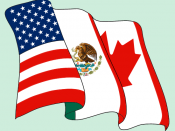"Behind a tariff wall built by Washington, Hamilton, Clay, Lincoln, and the Republican presidents who followed, the United States had gone from an agrarian coastal republic to become the greatest industrial power the world had ever seen -- in a single century. Such was the success of the policy called protectionism that is so disparaged today."
- Buchanan on the history of U.S. protectionism:
Historical Perspectives on U.S. Trade Policy
The recent debate over the North American Free Trade Agreement (NAFTA) has sparked off fears that domestic political support for liberal U.S. trade policies may be waning. In this context, it is imperative to understand the historical evolution of US trade policy and the move toward a more liberal trade policy stance since World War II.
The phase of high-tariff's (1880 - 1930)
The U.S. Civil War marked the beginning of a long period of high tariffs, which served the dual purpose of raising revenue for the federal government and keeping out foreign goods, for the protection of U.S.
labor and business. Yet, by the mid-1880s a curious problem had arisen: though much of the debt had been paid off, federal revenues were outstripping expenditures by as much as 50 percent.
It is interesting to note that though Republican and Democratic politicians agreed that the fiscal surplus should be reduced, they proposed exactly the opposite policies for achieving this objective. While the Democrats advocated cutting tariff rates in an effort to reduce revenue arguing that this would simply encourage imports and raise even more revenue, the Republicans proposed higher tariff rates to reduce fiscal revenue. This debate essentially hinged on whether existing tariffs were above or below the revenue-maximizing rate, which in turn depended on the height of the tariff and the price elasticity of import demand.
The tariff was...


